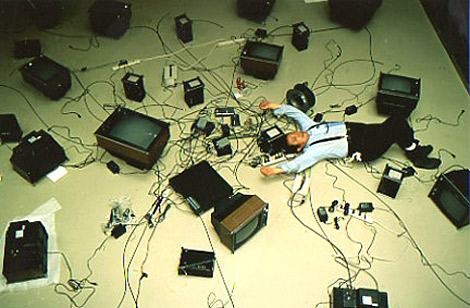« A Trophy for the Installation | Eye Level Home | Jamaica Kincaid on Being Kept In »
Paik for Everyone
May 1, 2009

Nam June Paik with his televisions, 1991, © Nam June Paik Studios, Inc.
The American Art Museum has dedicated quite a bit of floor space to the incredible works of Nam June Paik, who is often called the "father of video art." The museum has several works by Paik on permanent public view, including an early work called Zen for TV (1963/1976) and two of his ambitious and massive video walls, Electronic Superhighway: Continental U.S., Alaska, Hawaii (1995) and Megatron/Matrix (1995). Now American Art is home to the Nam June Paik Archive, the complete estate archive, which documents the artist’s fifty-plus year career.
I had the great fortune to talk about Paik and the Archive with one of the world’s leading experts on Paik, John G. Hanhardt, who is the Museum’s consulting senior curator of film and media art.
LB Congratulations on bringing the Paik Archive to American Art. What does this gift mean to you and to the Museum?
JGH Speaking personally from the perspective of a thirty-year career supporting the media arts, bringing this archive here is an extraordinary achievement—a dream come true!—representing an unprecedented opportunity to make ground-breaking advances in our understanding of the major developments in art and technology that have transformed contemporary art. I can’t wait to delve into this material more fully, and to share what I find with the art community.
LB How influential was Nam June Paik?
JGH Nam June Paik virtually single-handedly transformed video into an artist’s medium. His art and ideas embodied a radical new vision for an art form that spoke to contemporary issues through the exploration of time and memory and the creation of powerful visual metaphors.
Furthermore Paik is really a "hot" topic in today’s art world. Artists, in particular a new generation of Internet artists, have felt his influence for a while now, but the breadth of his reach is coming into focus in the critical and scholarly communities. He is a constant source of reference and inspiration to young curators and critics from New York to Los Angeles, Berlin, and Shanghai.
LB And how important is this Archive?
JGH The Paik Archive provides an opportunity to give a fuller picture of this seminal artist and that is essential to creating the yet unwritten global history of the moving image in twentieth-century art. We’ll have a chance to see how Paik rebuilt and programmed the hardware he used, how he invented new tools to achieve his artistic vision, and to trace his relationships with other influential figures such as John Cage and George Maciunas. Going through this material will be fascinating.
LB How did it come to the Museum?
JGH The Archive is a gift of the Paik Estate through its executor Ken Hakuta, the artist’s nephew, with the agreement of Shigeko Kubota, the artist’s widow. But the Museum had to compete to get the Archive. The estate invited selected museums to present proposals for how each would use it, and we’re grateful to Ken for allowing us to submit a proposal. American Art won out in the end, thanks in part to our strong commitment to artist estates and archives including those of Joseph Cornell and Christo and Jean-Claude among others.
LB How will this material be used by the public?
JGH Once the Archive is fully catalogued, it will be made available by appointment, and I’ll be developing a series of exhibitions using artworks and documentary materials from the Archive that will present different aspects of Paik’s creative process and tell the story of his groundbreaking ideas.
LB Thanks John. I’m going to let you get back to sorting through all this great stuff.
Posted by Laura on May 1, 2009 in American Art Here
Comments
I believe our future generations will see through Nam June Paik’s display his vision for the future, a true technological genius that understood what was coming.
Posted by: Marina Henriquez | May 7, 2009
i always find archival events like these to be more enlightening than discussion of an artists work. Perhaps, and especially in this case, it is rare to ever hear an art historian (case and point: this article) SAY anything about an artist. It's possible that I'm just peeving out over nothing but i simply hate seeing cloudy statements like "exploration of time and memory" next to incredibly ambitious statements such as "creating the yet unwritten global history of the moving image in twentieth-century art." Where is the precision, the concreteness? It's just the same as the most incredibly ebullient and nebulous adspeak and political blah blah.
Posted by: ron | May 13, 2009



Recent Comments